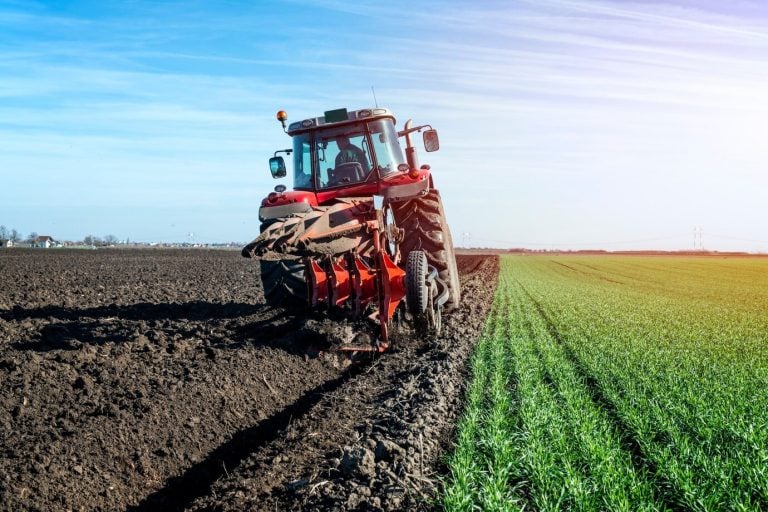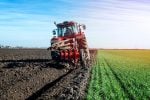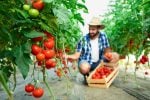Farming techniques have changed more in the past decade than in the previous century. The farmer who sticks with traditional methods today faces a brutal truth: they will be left behind, compromising their profitability .
In 2025, modern farming isn’t just about growing crops—it’s about using technology, data, and smart techniques to maximize yields and productivity while protecting our planet and promoting biodiversity. From American prairies to Asian rice fields, and increasingly in urban environments, the best business farmers have abandoned old ways in favor of methods that save money, increase output, and reduce environmental harm. The World Bank emphasizes the importance of climate-smart agriculture as a key driver of sustainable development and food security.
What if you could cut your water usage by 30% while increasing crop yields by 25%? What if sensors could tell you exactly when to plant, water, and harvest, taking guesswork out of the equation and allowing farmers to gain insights into their operations? These aren’t hypothetical questions. They’re the reality for businesses using today’s top farming techniques.
The gap between farms using advanced farming techniques and those clinging to tradition grows wider each season, particularly regarding soil fertility. The difference isn’t just in yield—it’s in profit margins, sustainability, and long-term viability.
Right now, someone in your industry is implementing no-till farming to cut labor costs. Another competitor is using drones to spot plant diseases before they spread. Someone else is using AI to predict market demands six months ahead.
The question isn’t whether these techniques work—the data proves they do. The question is: Will you adopt them before your competitors?
In this comprehensive guide, we’ll explore the farming techniques that successful agricultural businesses around the world are using to stay ahead in 2025. These aren’t theoretical concepts—they’re practical, proven approaches you can implement today.
Lower your delivery costs by 23%
How we reduce costs:
- No delivery vehicle expenses
- Optimized local routes
- Pay-per-delivery model
- Average 23% delivery cost reduction
Key Sustainable Agriculture Practices for 2025
- Sustainable agriculture is shifting from harm reduction to positive environmental impact.
- Farmers adopting these practices see 15-30% cost reduction and improved soil health.
- Most profitable farming combines these sustainable methods with high-value crop selection
No-Till Farming
No-till farming is a practice where crops are grown without disturbing the soil through tillage. This technique has gained significant traction in recent years, with adoption rates increasing by 8% annually since 2020. By 2025, approximately 45% of U.S. farmland is expected to use some form of no-till practices.
The primary mechanism behind no-till farming is the preservation of soil structure and the natural ecosystems within it. When farmers don’t till the soil, they maintain the complex networks of fungi, bacteria, and other microorganisms that support plant health. These microbiomes break down organic matter, cycle nutrients, and create soil structures that retain water better than conventionally tilled soil, resulting in enhanced soil health.
Research from the USDA’s Agricultural Research Service shows that no-till practices can reduce soil erosion by up to 90% compared to conventional tillage. This dramatic reduction protects topsoil—the most valuable layer for agriculture—from being washed or blown away. Beyond soil conservation, no-till farming reduces fuel consumption by 50-80% and labor requirements by up to 60%, resulting in significant cost savings.
Implementation Challenges and Solutions
Despite its benefits, transitioning to no-till farming presents challenges. The initial three years often show reduced yields as soil ecosystems adjust. Farmers must also invest in specialized equipment like no-till drills and planters that can cut through crop residue, alongside exploring biological pest control methods.
Successful no-till farmers manage these challenges through:
- Gradual transition periods (starting with 20-30% of land)
- Strategic use of cover crops to suppress weeds
- Precise timing of planting to work with natural soil warming cycles
- Integration with other sustainable practices like e-controlled traffic farming
Crop Rotation and Diversification
Crop rotation and diversification stand as pillars of sustainable farming, with their implementation becoming increasingly sophisticated in 2025. This practice involves growing different crops in sequence on the same land, rather than planting the same crop repeatedly, aligning with organic farming principles. Modern rotations typically involve 3-7 crops depending on the region and market demands. Understanding the different categories and characteristics of crops is essential for implementing effective crop rotation and diversification strategies. Familiarity with various crop types helps farmers select the right sequences to optimize soil health and economic returns. For a detailed overview, check out this comprehensive guide on the “five main varieties of crops and their importance in agriculture.”
Choosing the right crop types is fundamental to successful rotation and diversification. Different crops offer unique benefits, such as nitrogen fixation, pest disruption, or organic matter contribution. For farmers looking to deepen their practical knowledge, an insightful resource on the different categories of crop types and their agricultural significance provides a solid foundation. This resource explains how specific crop selections can influence soil health, pest dynamics, and overall farm productivity.
Understanding the distinct classifications of crops can greatly enhance the effectiveness of rotation and diversification practices. By recognizing the specific nutritional and growth characteristics of various crop types, farmers can design crop sequences that maximize nutrient recycling and pest management. For a thorough exploration of these categories, you might want to explore an informative resource on different types of crops and their significance, which provides valuable insights into their agricultural roles.
The science behind crop rotation centers on breaking pest and disease cycles while building soil health. When the same crop grows continuously, specific pests and pathogens accumulate in the soil. Different crop families have different nutrient needs and root structures, so rotating them helps maintain soil balance. For example, following corn (a heavy nitrogen user) with legumes (nitrogen fixers) helps replenish soil nitrogen naturally.
European farmers employing strategic crop rotations report 15-25% higher yields and up to 40% reduction in synthetic inputs compared to monoculture systems. In Asia, rice-fish-duck integrated systems demonstrate how diversification can create multiple income streams while reducing environmental impact.
Economic Benefits of Diversification
Farm diversification extends beyond field rotation to include market diversification. Farms growing 6+ commercial crops experience 30% less income volatility than those growing 1-2 crops, according to research from agricultural economists at Cornell University.
Practical diversification strategies for 2025 include:
- Integration of perennial crops into annual rotations
- Addition of high-value specialty crops in rotation blocks
- Incorporation of dual-purpose crops (grain/forage)
- Strategic use of catch crops between main rotations
Integrated Pest Management (IPM)
Integrated Pest Management represents a sophisticated approach to controlling pests, diseases, and weeds while maximizing environmental sustainability and minimizing environmental harm. By 2025, IPM has evolved beyond simple pesticide reduction to become a comprehensive ecosystem management strategy, incorporating various eco-friendly practices.
Modern IPM systems rely on extensive monitoring and ecological knowledge. Farmers using IPM start by establishing economic thresholds—the pest population level at which treatment becomes financially necessary. This prevents unnecessary pesticide applications for non-threatening pest populations. Advanced monitoring technologies now include automated insect traps with image recognition, satellite-based disease detection, and soil DNA analysis to identify potential threats before they emerge.
Biological controls form the foundation of IPM strategies. These include releasing beneficial insects like ladybugs and parasitic wasps, applying targeted microbial controls, and managing habitats to support natural predators. Research shows that farms implementing comprehensive IPM strategies reduce pesticide use by 50-90% while maintaining or improving crop yields.
Technology Integration in IPM
The integration of technology with ecological knowledge defines IPM systems in 2025:
- AI-based decision support systems analyze weather, pest populations, and crop stages to recommend precision interventions
- Robotic weeders use computer vision to target specific weeds while leaving crops untouched
- Gene editing helps develop crops with enhanced natural resistance to specific pests
- Weather forecasting algorithms predict pest pressure days or weeks in advance
Regenerative Agriculture and Organic Farming
Regenerative agriculture represents a significant advancement beyond sustainability, focusing not just on maintaining agricultural systems but improving environmental conditions through farming practices. This approach has gained substantial momentum, with over 250 major food companies committing to regenerative supply chains by 2025, which directly benefits our natural resources. To dive deeper into practical implementations, check out this detailed guide on transformative regenerative agriculture practices that are reshaping farms and boosting productivity. These proven methods emphasize soil health, biodiversity, and carbon sequestration to create resilient farming systems.
To truly harness the power of regeneration in agriculture, farmers must adopt proven methods that not only restore soil but also enhance biodiversity and boost productivity. Our top regenerative farming practices provide an actionable roadmap for those looking to transform their land and yields sustainably. These techniques have been field-tested and demonstrate measurable benefits, making them essential in modern sustainable farming.
For those interested in expanding their knowledge further, exploring eight key regenerative agriculture practices can offer valuable practical insights. These techniques highlight how farms can enhance soil vitality, increase biodiversity, and boost productivity through thoughtful, science-backed strategies.
The core principle of regenerative agriculture is building soil organic matter—the foundation of soil health. Practices include minimizing soil disturbance, keeping soil covered with living plants year-round, integrating livestock, and maximizing biodiversity. Research from the Rodale Institute indicates regenerative systems can sequester 3-7 tons of carbon dioxide equivalent per acre annually while increasing water infiltration rates by 40-60%.
Farmers implementing regenerative systems report production costs decreasing by 25-35% over five years as soil health improves and external input requirements decline. While yields may initially drop during transition, they typically recover and often exceed conventional yields by years 3-5, especially during extreme weather events, where regenerative farms show 20-40% better resilience.
Climate-Smart Water Management and Eco-Friendly Practices
Water management has become a critical component of sustainable agriculture as climate change alters precipitation patterns worldwide. By 2025, advanced water management goes beyond efficiency to include water capture, storage, and quality protection.
Modern agricultural water systems integrate multiple approaches: precision irrigation delivers water exactly when and where crops need it, reducing usage by 30-60% compared to conventional irrigation. Soil moisture sensors, satellite data, and weather forecasting allow farmers to make irrigation decisions based on real-time conditions rather than fixed schedules.
Beyond efficiency, water storage has become essential. Farms in areas with seasonal rainfall now capture water during wet periods for use during dry seasons. This includes constructing ponds and reservoirs, but also building soil organic matter and planting trees —each 1% increase in organic matter helps soil hold approximately 20,000 gallons more water per acre.
Most Profitable Farming Approaches in 2025
The question of which farming methods generate the highest profits depends significantly on location, scale, and market access. However, clear patterns have emerged by 2025.
High-value specialty crops combined with sustainable practices consistently generate the highest per-acre profits. Organic vegetables produced using regenerative methods near urban areas can generate $20,000-$50,000 gross revenue per acre. These intensive systems require significant labor and management but deliver premium returns.
For larger-scale operations, the integration of complementary enterprises proves most profitable. Grain farms that add livestock components report 15-30% higher returns per acre than grain-only operations. The livestock convert crop residues and cover crops into marketable products while providing natural fertility, which can also support the growth of fruit trees.
Greenhouse and controlled environment agriculture (CEA) represent another high-profit sector, with properly managed operations generating $300,000+ gross revenue per acre. These systems require a high initial investment but offer protection from climate volatility and enable year-round production.
How Advanced Precision Farming Boosts Yields
- Advanced precision farming increases crop yields by 6% on average
- Sensor and GPS technologies reduce input costs by 15-30%
- Real-time data collection enables timely interventions that prevent crop losses
Sensor Technologies
Soil sensors have transformed modern farming by providing continuous monitoring of key variables that affect plant growth. Basic sensors measure moisture levels at different soil depths, helping farmers apply water only when needed, reducing reliance on chemical fertilizers. More advanced models track nutrient levels, pH, and soil temperature—all critical factors that determine crop health.
Wireless sensor networks now enable farmers to monitor entire fields remotely without manual checks. These systems collect data and transmit it to central computers or smartphones, creating detailed soil health maps. Farmers can review this information from anywhere and make decisions based on actual field conditions rather than guesswork. The practical impact is significant: many farms report 15-25% reductions in water usage after implementing sensor systems.
Weather sensors complement soil monitoring by tracking local conditions like rainfall, humidity, wind speed, and solar radiation. This hyperlocal weather data helps farmers make better decisions about planting, irrigation, and harvest timing. According to agricultural research, precise weather monitoring can help prevent up to 30% of potential crop losses by enabling farmers to take protective measures before extreme weather events.
Data Integration and Analysis
The true power of sensor technology emerges when data from multiple sources is integrated and analyzed together. Modern farm management systems collect information from soil sensors, weather stations, equipment sensors, and satellite imagery to create comprehensive field intelligence.
These systems use algorithms to detect patterns and anomalies that human observers might miss. For example, early signs of disease or pest infestation can be identified through subtle changes in plant appearance or growth patterns before they become visible to the naked eye. “Precision farming provides farmers with current, historical, and future weather analytics to make informed decisions and increase crop yield,” notes a report from agricultural experts.
GPS-Enabled Equipment
GPS technology has revolutionized farming precision by enabling equipment to navigate fields with centimeter-level accuracy. Modern tractors and implements use Real-Time Kinematic (RTK) GPS systems that are accurate to within 2.5 cm, allowing for incredibly precise field operations. This technology eliminates overlaps during planting, spraying, and harvesting, reducing seed, fertilizer, and chemical waste by 5-15% across operations.
Auto-steering systems paired with GPS have become standard on modern farm equipment. These systems take over steering functions, allowing operators to focus on monitoring equipment performance rather than driving straight lines. The benefits extend beyond precision—farmers report less fatigue after long workdays, which leads to fewer mistakes and accidents during critical planting and harvest periods.
Variable rate application (VRA) technology represents the next evolution in GPS-enabled farming. These systems adjust input application rates automatically as equipment moves across the field, based on prescription maps created from soil tests, yield data, and other field information. Fields rarely have uniform soil conditions, so VRA allows farmers to apply more inputs where needed and less where they aren’t—optimizing both crop growth and input costs.
Drone Surveillance
Agricultural drones have transformed from expensive novelties to essential farm tools. These unmanned aerial vehicles capture high-resolution images that reveal crop patterns invisible from ground level. Entry-level drones with basic cameras start around $1,000, while advanced models with multispectral sensors cost $5,000-15,000—still reasonable when spread across large acreages.
Drones excel at rapid crop scouting. A single drone can survey hundreds of acres in hours, compared to days for ground inspections. The overhead perspective makes it easier to spot issues like irrigation problems, pest hotspots, and nutrient deficiencies. Most importantly, drones detect problems earlier than ground inspections, when they’re still manageable with targeted treatments.
Multispectral and thermal imaging capabilities allow drones to see beyond what human eyes can detect. These specialized cameras capture light wavelengths that reveal plant stress before visible symptoms appear. Farmers can identify diseased areas up to two weeks before they become visible to the naked eye, enabling early intervention that prevents widespread crop damage, often by harnessing natural enemies.
Artificial Intelligence in Crop Management
Artificial intelligence systems now analyze the massive data streams generated by precision farming technologies. Machine learning algorithms identify patterns across seasons and predict likely outcomes based on current conditions. For example, AI systems can predict disease outbreaks by analyzing weather patterns, soil conditions, and historical disease data, often days before visible symptoms appear.
These predictive capabilities allow farmers to take preventive actions rather than reacting to problems. Research indicates that early intervention guided by AI predictions can prevent up to 40% of potential crop losses from diseases and pests. The economic impact is substantial—farmers avoid both the cost of treatments and the yield losses that would occur without them.
AI-powered decision support systems help farmers manage the complexity of modern agriculture. These systems integrate data from multiple sources and provide specific recommendations for each field section. Rather than applying a standard fertilizer rate across an entire field, for instance, farmers can optimize applications based on soil needs, expected yield potential, and economic considerations.
Yield Monitoring and Mapping
Yield monitors installed on harvesting equipment measure crop output in real-time as machinery moves through fields. These systems use various sensors—including impact plates, optical sensors, and weight measurements—to calculate yields with high accuracy. As one agriculture expert notes, “Yield maps are where precision ag began.”
Modern yield mapping creates detailed visualizations showing production variations across fields. These maps reveal patterns that might otherwise go unnoticed, such as consistently underperforming areas that need soil amendments or drainage improvements. Over multiple seasons, these maps become powerful decision-making tools that guide variable-rate applications and other precision farming practices.
The real value comes from analyzing multiple years of yield data alongside other field information. This longitudinal analysis helps farmers identify which factors consistently affect yields and which are more random or weather-dependent. With this knowledge, they can focus investments on addressing the most significant yield-limiting factors for their specific fields.
Trends for the Year in Global Farming Techniques
- Global farming saw major shifts to AI-based crop management and water conservation in 2025
- Precision agriculture tools reduced resource use by 30% while maintaining or improving yields.
- Vertical farming and regenerative practices gained mainstream business adoption worldwide.
AI-Driven Decision-Making
The agricultural sector experienced a dramatic shift toward AI-powered farming systems throughout 2025. In January, adoption rates for AI decision support tools stood at 35% among commercial farms in North America and Europe. By December, this figure jumped to 51%, representing one of the fastest technology adoption curves in modern agriculture.
Early in the year, farms primarily used AI for basic predictive analytics – forecasting weather patterns and estimating optimal planting dates. The first quarter saw notable success with AI-driven planting schedules, with farmers reporting 12-18% improvement in germination rates when following AI recommendations versus traditional planting calendars. These early wins drove further investment in more sophisticated systems during the spring planting season.
By mid-year, the focus shifted to more complex applications. The most significant development came in July when several major agricultural technology companies released integrated AI platforms that combined satellite imagery, soil sensor data, and market pricing algorithms. These systems analyze millions of data points to make specific recommendations about crop selection, resource allocation, and harvest timing.
AI-Powered Crop Classification and Monitoring
The second half of 2025 saw remarkable advances in crop classification systems. New computer vision technologies achieved identification accuracy rates above 98% for major crops, allowing for automated monitoring of plant health across vast acreages. These systems detect early signs of disease, nutrient deficiencies, or pest pressure, often before they become visible to the human eye.
Transfer learning techniques proved particularly valuable, with many farms adopting pre-trained models based on EfficientNetV2 and ResNet152V2 architectures. These models required minimal adaptation to local conditions while delivering exceptional accuracy. By fall harvest, farms using these advanced crop monitoring systems reported reducing pesticide applications by 27% while maintaining or improving crop quality.
Sustainable Water Management
Water conservation emerged as perhaps the most critical trend in global agriculture during 2025. January began with over 40% of agricultural regions worldwide experiencing abnormal drought conditions, creating urgent demand for water-efficient farming methods that can also combat deforestation. The response was swift and innovative, with dramatic increases in water-saving technology adoption throughout the year.
Smart irrigation systems saw the most rapid deployment, with installations increasing 63% year-over-year. These systems analyze weather data, soil moisture levels, and crop water requirements to deliver precisely the right amount of water exactly when needed. Farms implementing these technologies reported water usage reductions of 30-45% while maintaining or even improving yields in many cases, which can lead to additional income.
The middle months of 2025 brought increased focus on subsurface drip irrigation, which delivers water directly to root zones, minimizing evaporation losses. Adoption rates for this technology doubled between May and October, particularly in water-stressed regions across the American West, Mediterranean countries, and Australia. The technology proved especially valuable for tree crops and vineyards, where targeted water delivery improved fruit quality while reducing overall water consumption.
Rainwater Harvesting Systems
Rainwater harvesting emerged as a complementary strategy, with innovative collection and storage systems becoming mainstream on farms worldwide. Early 2025 saw the introduction of advanced catchment materials that improved collection efficiency by up to 35% compared to traditional systems, especially in areas where trees provide shade. These materials, combined with smart storage solutions, allowed farms to capture significant portions of their water needs even in regions with modest rainfall.
By mid-year, integrated water management systems combining rainwater harvesting with precision irrigation gained popularity. These systems prioritize stored rainwater for irrigation, switching to groundwater or municipal sources only when necessary. Farms using these integrated approaches reported reducing their external water footprint by 25-40% compared to conventional irrigation practices.
The final quarter of 2025 brought increased attention to water quality management. New filtration technologies made rainwater suitable for a wider range of agricultural applications, including greenhouse production and livestock operations. These advances expanded the potential applications for harvested rainwater, further reducing dependency on stressed aquifers and municipal water supplies.
Water Footprint Reduction Strategies
Water footprint analysis became standard practice across commercial agriculture in 2025. Beginning in March, major food processors and retailers began requiring water usage reporting from their suppliers, creating strong incentives for water efficiency. This market pressure accelerated the adoption of monitoring technologies that track water consumption across all farm operations.
Summer brought a new focus on crop selection as a water conservation strategy. Drought-tolerant crop varieties gained market share, with seed sales for these varieties increasing 42% year-over-year. These crops maintain productivity with significantly less irrigation, making them increasingly attractive as water costs rise and availability becomes less certain, thereby contributing to food security.
The year concluded with growing interest in deficit irrigation strategies — deliberately applying less water than crops would ideally use during less sensitive growth stages. Research published in October showed that carefully managed deficit irrigation could reduce water use by 15-25% while decreasing yields by only 3-7%, often improving water use efficiency by more than 20%. These strategies spread rapidly in regions facing severe water constraints, suggesting they will remain important in 2026.
Vertical Farming Expansion
Vertical farming moved decisively from niche technology to mainstream agricultural practice during. January began with approximately 1,200 commercial vertical farms operating globally; by December, that number had grown to over 2,100 facilities. This explosive growth came as the technology proved its economic viability for a wider range of crops beyond the leafy greens that dominated early vertical farming operations.
The first quarter saw breakthroughs in lighting efficiency, with next-generation LED systems reducing energy costs by 38% compared to 2024 technology. These advances significantly improved the economics of indoor growing, expanding the range of crops that can be profitably grown in controlled environments. By April, commercial vertical farms were successfully producing strawberries, cherry tomatoes, and herbs at competitive price points in major urban markets.
Mid-year brought increased integration of vertical farms into urban food systems. New facilities opened within city limits in 27 major metropolitan areas worldwide between May and August. These operations delivered ultra-fresh produce to urban consumers within hours of harvest, often commanding premium prices based on flavor, freshness, and reduced transportation impacts.
The final months of 2025 saw vertical farming companies forming strategic partnerships with traditional field producers. These collaborations create complementary growing systems, with weather-sensitive crops moving indoors while field operations focus on crops better suited to outdoor conditions. This trend toward hybrid production models will likely accelerate in 2026 as both sectors recognize the benefits of collaboration rather than competition.
Regenerative Agriculture Goes Mainstream
Regenerative farming practices transitioned from experimental approaches to standard business practice throughout 2025. The year began with approximately 8% of global agricultural land under some form of regenerative management; by December, this figure had reached 14% and continues to grow rapidly, in part due to the contributions of women farmers.
The first quarter revealed compelling economic data driving this shift. Studies published in February showed farms using regenerative practices for 3+ years averaged 22% lower input costs and 18% higher net profits per acre compared to conventional operations, even before considering premium pricing or carbon credits. This economic case accelerated adoption among commercial producers previously skeptical about regenerative methods.
By mid-year, carbon markets had matured significantly, creating additional revenue streams for regenerative farmers. Average carbon credit values increased 45% between January and July as major corporations sought high-quality agricultural offsets to meet climate commitments. Farms with documented increases in soil carbon were able to generate supplemental income ranging from $30 to-120 $ acre, depending on practices and verification protocols.
The final months of 2025 saw increased attention to the resilience benefits of regenerative systems. Farms using these practices generally weathered weather extremes better than conventional operations, showing 35% less yield loss during drought conditions and 27% less damage from heavy precipitation events. This demonstrated resilience convinced many remaining skeptics that regenerative practices represented sound risk management rather than idealistic environmentalism, particularly as they reduce dependence on synthetic pesticides.
Looking Ahead: The Next 12 Months in Agricultural Innovation
As we move into 2026, several key developments appear likely to shape global farming techniques. First, we anticipate accelerated integration of currently separate technologies into comprehensive farm management systems. The AI decision support tools, water conservation technologies, and regenerative practices that were developed separately in 2025 will increasingly function as coordinated systems rather than isolated innovations.
Second, agricultural technology will become more accessible to mid-sized and smaller operations. Many innovations that began with large commercial enterprises have been redesigned for smaller-scale applications, with more affordable entry points and simplified user interfaces. This democratization of agricultural technology will likely accelerate in 2026, spreading benefits across a wider range of farm sizes and types.
Finally, consumer preferences will increasingly drive farming practices through market demand. Food companies reported significant sales growth for products with verified sustainability credentials in 2025, creating strong incentives for farms to adopt and document improved practices. This market-driven sustainability push will continue shaping farming decisions throughout 2026 and beyond, ultimately enhancing food security.
For agricultural businesses navigating these trends, the most prudent approach combines strategic technology adoption with flexibility. Rather than attempting to implement every innovation simultaneously, successful operations identify their most significant challenges and opportunities, then select technologies that address these specific needs. This targeted approach delivers better returns on investment while building capabilities for further innovation as technologies mature.
Farming Practices For Business
The farming landscape of 2025 shows that business success comes from blending time-tested methods with cutting-edge tools. No-till farming preserves soil while saving costs. Precision agriculture with sensors and drones provides data for smarter decisions. Greenhouses with climate control systems deliver year-round production. Organic methods reduce environmental impact while meeting consumer demand. Embracing sustainability is no longer optional; it drives long-term profitability and environmental stewardship. For those aiming to incorporate eco-friendly methods seamlessly into their operations, exploring tested and verified sustainable farming strategies is invaluable. These practices not only boost yields but also safeguard essential resources, positioning farms for resilience and growth in an evolving agricultural landscape.
Adopting a comprehensive suite of effective sustainable farming methods is key to transforming modern agriculture. These practices encompass soil conservation, integrated pest management, water-saving techniques, and crop diversification. By implementing these approaches, farmers not only increase productivity but also enhance ecological balance, ensuring the long-term viability of their operations. Transitioning to these methods requires careful planning and commitment but offers substantial rewards both economically and environmentally.
Looking ahead to 2026, watch for vertical farming in urban areas, regenerative practices that heal ecosystems, and blockchain systems that track food from seed to store. The most successful agricultural businesses will be those that adapt these top farming techniques to their specific regions and markets. An essential resource for those eager to deepen their understanding is this detailed guide on effective sustainable farming practices. It offers insight into techniques that not only improve productivity but also foster long-term ecological balance, ensuring the farm’s health and profitability for years to come.
Embracing sustainable farming methods is increasingly recognized as a critical strategy for future-ready agriculture. These strategies integrate environmental care with economic viability, ensuring farms thrive while protecting natural resources. To explore deeper insights and actionable steps, explore this comprehensive overview of key sustainable farming strategies that are shaping greener agricultural futures.
The future of farming isn’t just about technology—it’s about balance. Finding the sweet spot between innovation and sustainability. Between profit and planet care. Between feeding today’s populations and protecting tomorrow’s resources. Understanding the broader significance of agriculture enhances our appreciation for these innovations. Agriculture is the backbone of economies, culture, and survival worldwide. For deeper insights into its vital role, explore comprehensive discussions on the impact of farming and why it remains crucial to societies in this detailed post on why farming matters globally.
Recognizing why agriculture holds such a pivotal place is essential for anyone involved in farming today. It not only sustains populations by providing food but also underpins economic stability, cultural heritage, and national development around the globe. Insights into these foundational roles can inspire more informed decisions in agricultural innovation and sustainability. To further appreciate these critical aspects, consider reading this insightful article on the important reasons agriculture shapes our world, which offers a comprehensive view on its global significance.
For those interested in expanding their knowledge on the fundamental importance of agriculture, this detailed article on the key reasons why agriculture is important offers valuable insights. It highlights how agriculture not only feeds populations but also shapes economies, supports cultural traditions, and drives national development, reinforcing the critical role it plays across the globe.
For business owners and farm managers, the path forward is clear: start with one or two techniques that make sense for your operation, measure results carefully, and scale what works. Your business success and our food security depend on it.














